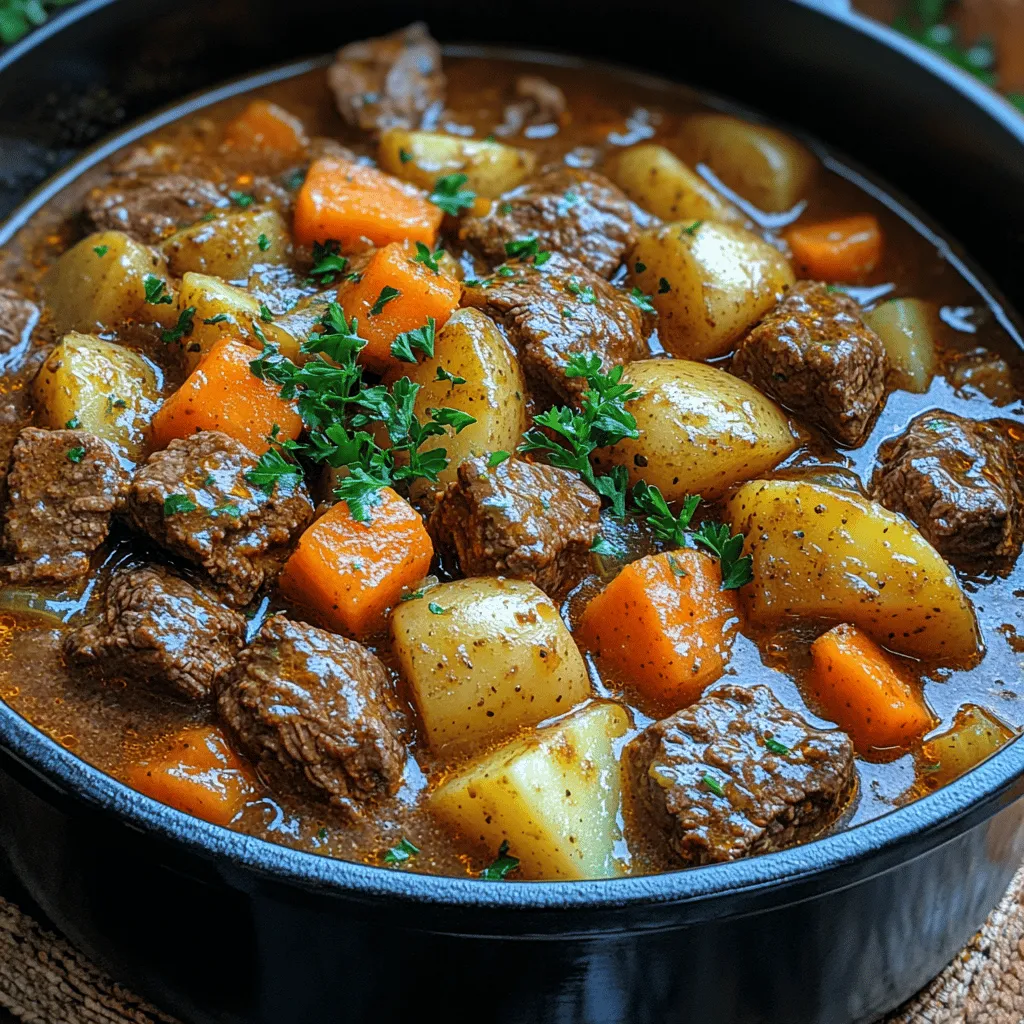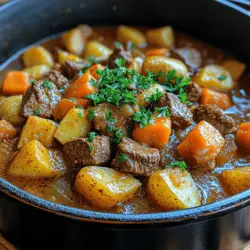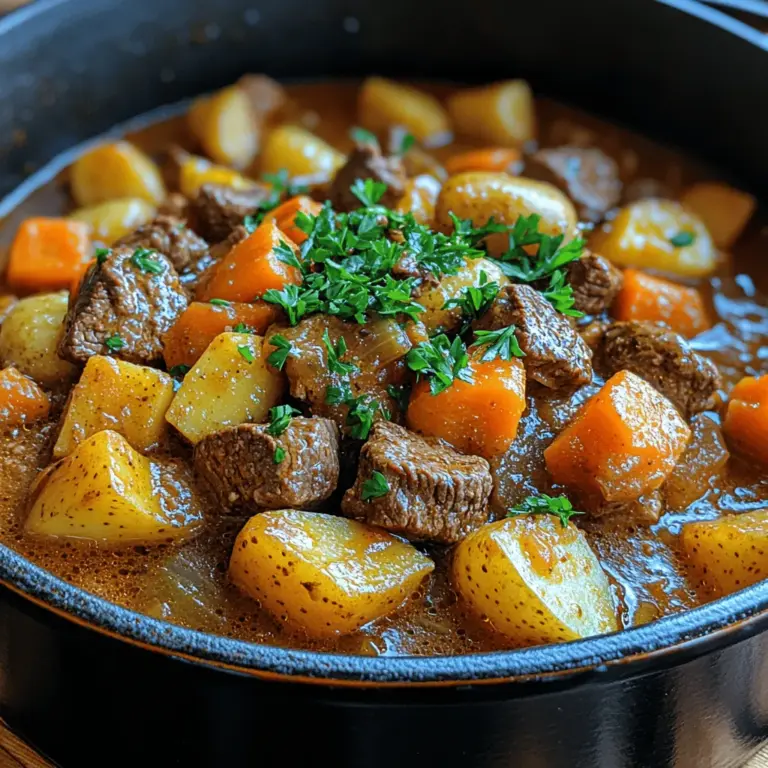Introduction
When the temperatures drop and the nights grow longer, there’s nothing quite like a warm, hearty bowl of beef stew to bring comfort and cheer to the table. Beef stew is more than just a meal; it’s a timeless classic that evokes memories of family gatherings, cozy evenings by the fireplace, and the comforting scents of home-cooked goodness wafting through the air. This dish has been a staple in kitchens around the world, cherished for its ability to nourish both body and soul.
The appeal of homemade beef stew lies not only in its rich flavor but also in its versatility. Whether you’re hosting a family dinner, preparing a meal for guests, or simply craving a satisfying dish to warm your heart, beef stew adapts to every occasion. It combines tender chunks of beef with hearty vegetables, all simmered together in a savory broth that makes each bite a delightful experience. As we embark on this culinary journey, we will explore a cozy beef stew recipe that promises to become a favorite in your household, offering a delightful blend of flavors and textures that will leave everyone asking for seconds.
Understanding the Ingredients
Creating a delicious beef stew starts with understanding the key ingredients that bring this dish to life. Each element plays a crucial role in developing the rich, comforting flavors that make beef stew such a beloved classic.
The Choice of Beef: Why Beef Chuck?
The foundation of any great beef stew is, of course, the beef itself. For this recipe, beef chuck is the ideal cut to use. This particular cut comes from the shoulder of the cow, which means it has a good amount of connective tissue and fat. When slow-cooked, beef chuck becomes incredibly tender and flavorful. The marbling in the meat breaks down during the cooking process, enriching the stew with a deep, savory flavor that’s hard to beat.
Opting for beef chuck not only enhances the taste but also makes for a more economical choice—ideal for making a large batch to feed a crowd or for meal prep. As the beef simmers, it infuses the broth with a luxurious richness, making every spoonful a delightful experience.
Fresh Vegetables: Onions, Carrots, and Potatoes
No beef stew is complete without a medley of fresh vegetables. Onions, carrots, and potatoes are traditional staples that add texture, flavor, and nutrition to the dish. Onions serve as the aromatic backbone, providing a sweet and savory depth that complements the beef. Carrots add a hint of sweetness and a vibrant color, while potatoes contribute heartiness and help thicken the stew as they cook down.
Using fresh vegetables is essential for achieving the best flavor and texture. Look for firm, unblemished vegetables to ensure your stew tastes its best. Other vegetables like celery or peas can also be added for variety, but the classic trio of onions, carrots, and potatoes creates a balanced and satisfying dish.
The Role of Red Wine (or Beef Broth)
To elevate the flavor profile of your beef stew, incorporating red wine or beef broth is key. Red wine not only adds depth but also enhances the overall richness of the stew. The acidity in wine helps to tenderize the meat while adding complex flavors that complement the beef and vegetables beautifully. If you prefer to avoid alcohol, high-quality beef broth works just as well, providing a savory base that helps build layers of flavor as the stew simmers.
Spices and Herbs: Thyme, Rosemary, and Bay Leaves
The aromatic herbs and spices are what truly make this beef stew irresistible. Thyme and rosemary are classic herbs that pair perfectly with beef, imparting a fragrant aroma and earthy flavor. Bay leaves add a subtle depth that enhances the overall taste of the dish.
When using herbs, fresh is often best, but dried herbs can also work in a pinch. If using dried herbs, remember that they are more concentrated, so you’ll need less. A little goes a long way, and the right combination of spices will transform your stew into a comforting masterpiece.
Preparation Steps for the Perfect Beef Stew
Now that we have a solid understanding of the ingredients, it’s time to dive into the preparation steps that will guide you in creating the perfect beef stew.
Browning the Beef
The first step in making a flavorful beef stew is to properly brown the beef. Searing the meat creates a rich crust that adds depth of flavor to the dish. To achieve this, start by cutting your beef chuck into uniform chunks, about 1 to 2 inches in size. This ensures even cooking throughout.
Next, heat a large pot or Dutch oven over medium-high heat and add a tablespoon of oil—olive oil or vegetable oil works well. Once the oil is hot and shimmering, add the beef in batches, making sure not to overcrowd the pot. Overcrowding can lead to steaming rather than browning, which diminishes the flavor.
Allow the beef to sear on one side without moving it for a few minutes until a nice brown crust forms. Then, turn the pieces to brown all sides evenly. This process should take about 8-10 minutes, and once done, transfer the beef to a plate and set it aside. This step may seem simple, but it’s crucial for developing the rich, complex flavors that make your stew memorable.
Sautéing the Aromatics
With the beef browned, it’s time to build the flavor base by sautéing the aromatics. In the same pot, add a bit more oil if needed and toss in chopped onions and minced garlic. The onions will begin to soften and caramelize, releasing their natural sweetness, while the garlic adds a fragrant aroma.
Sauté the onions until they become translucent and slightly golden, usually about 5-7 minutes. Be mindful not to burn the garlic; it can turn bitter quickly. Stir frequently and keep an eye on the heat. If you notice the garlic browning too fast, lower the heat to prevent burning.
This step is essential as it forms the foundation of flavor for your stew. The sweet, aromatic notes from the sautéed onions and garlic will permeate the beef and vegetables, creating a harmonious blend of tastes that enrich the overall dish.
Building the Stew Base
Once your aromatics are ready, it’s time to build the stew base. Return the browned beef to the pot, along with any juices that have accumulated on the plate. Next, add your chopped carrots and potatoes, stirring to combine all the ingredients.
Now is the time to incorporate tomato paste, which adds an essential richness to the stew. A couple of tablespoons will do the trick. Stir it in and cook for a few minutes, allowing the tomato paste to caramelize slightly. This step deepens the flavor of the stew and adds a beautiful color.
After incorporating the tomato paste, it’s time to add in the liquids. Pour in your choice of red wine or beef broth, scraping the bottom of the pot with a wooden spoon to deglaze and lift any flavorful browned bits stuck to the bottom. This process is crucial as it enhances the stew’s flavor and ensures nothing goes to waste.
Deglazing the Pot
Deglazing is a simple yet powerful technique that can significantly enhance the taste of your stew. As mentioned, it involves adding a liquid (in this case, red wine or beef broth) to the pot after browning the meat and sautéing the aromatics.
The liquid helps dissolve the caramelized bits of food stuck to the bottom of the pot, which are packed with flavor. To deglaze effectively, pour in the liquid and use a wooden spoon to scrape the bottom while bringing the mixture to a simmer. This process not only adds depth to the stew but also prevents burning, ensuring a smooth, rich broth.
Once the pot is deglazed, you can add your herbs—thyme, rosemary, and bay leaves—and any additional seasonings like salt and pepper. Bring the mixture to a gentle boil, then reduce the heat to low, cover the pot, and let it simmer. The slow cooking process allows the flavors to meld beautifully, resulting in a comforting beef stew that fills your home with delightful aromas.
As we continue to prepare this cozy comfort beef stew, remember that patience is key. Letting the stew simmer for a few hours will transform the ingredients into a warm, inviting dish that’s perfect for any occasion. Get ready to enjoy a hearty meal that warms both your heart and your home!

How to Properly Scrape the Pot for Maximum Flavor Extraction
Once the beef is browned and removed from the pot, it’s essential to scrape the bottom thoroughly. This step, often overlooked, is crucial for flavor extraction. The browned bits, known as fond, cling to the bottom of the pot and are packed with rich, savory flavor.
To scrape the pot effectively, return the heat to medium and add a splash of broth or water, using a wooden spoon to gently dislodge the fond. As it loosens, you’ll hear a satisfying sizzle. Make sure to incorporate all those flavorful bits into the stew. This process not only enhances the depth of flavor in your beef stew but also adds a touch of complexity that elevates the dish from ordinary to extraordinary.
Combining Ingredients for Flavor Infusion
Once the fond is released, it’s time to add in your aromatics—onions, garlic, and any other vegetables you’re using such as carrots and celery. Stir these ingredients into the pot, allowing them to sweat and release their flavors. This typically takes about 5 minutes. The goal is to soften the aromatics while they absorb the fond flavor, creating a rich base for your stew.
Next, add the beef back into the pot along with any herbs and spices you prefer. Common choices include bay leaves, thyme, and rosemary, which each contribute their unique aromatic profiles. Pour in your broth, ensuring that all ingredients are submerged. This is also the moment to add any acidic components, such as tomatoes or red wine, which will not only enhance flavor but also help tenderize the meat as it cooks.
The Simmering Process and Its Transformative Power
Once all the ingredients are combined, bring the stew to a gentle simmer. This is a critical phase of cooking that allows the flavors to meld beautifully. Simmering is defined by tiny bubbles rising to the surface, rather than a rolling boil. This lower temperature is essential for tenderizing the beef and softening the vegetables without overcooking them.
Allow the stew to simmer for at least 1.5 to 2 hours, stirring occasionally. As it cooks, you’ll notice the aroma wafting through your kitchen, hinting at the delicious meal to come. The simmering process also thickens the stew naturally, as the starches in potatoes and any added flour from the slurry begin to release into the broth.
The Importance of Low and Slow Cooking for Tender Beef
The secret to a perfect beef stew lies in the low-and-slow cooking method. Cooking the beef at a low temperature allows the collagen in the meat to break down gradually. This results in melt-in-your-mouth tenderness. If the stew is cooked too quickly at high heat, the beef can become tough and chewy, detracting from the overall experience.
For optimal results, aim for a cooking time of at least 2 hours, though longer is even better. If you have the time, allowing the stew to simmer for 3-4 hours will yield even richer flavors and a more tender texture. Consider adjusting your cooking time based on the cut of beef you use; tougher cuts like chuck benefit immensely from extended cooking.
Thickening the Stew
Thickening your beef stew is an essential step that transforms it from a broth into a hearty dish. While the natural reduction from simmering will thicken the stew, you may want to enhance this further with a slurry technique.
Explanation of the Slurry Technique and Its Benefits for Texture
A slurry consists of equal parts cornstarch and cold water mixed until smooth. About 15-30 minutes before your stew is finished cooking, stir in the slurry and bring the stew back to a gentle boil. The heat activates the cornstarch, thickening the stew quickly without altering its flavor. This technique is preferred because it creates a velvety texture that clings to the beef and vegetables beautifully.
Tips for Adjusting Thickness According to Preference
If you prefer a heartier stew, feel free to add additional slurry until you reach your desired consistency. Conversely, if you accidentally make the stew too thick, you can always add more broth or water to achieve the right texture. Remember to taste as you go, ensuring that you maintain the balance of flavors.
Serving Suggestions and Pairings
When it comes to serving beef stew, presentation and side dishes play a significant role. To elevate your dish, consider garnishing with freshly chopped parsley. This not only adds a pop of color but also contributes a fresh flavor that balances the richness of the stew.
Ideas for Garnishing
Chopped parsley is a classic choice, but you could also experiment with fresh thyme or chives for added flavor. A dollop of sour cream or a sprinkle of grated cheese can also add creaminess and richness, enhancing the overall experience.
Recommended Side Dishes
Beef stew pairs beautifully with crusty bread, perfect for sopping up the delicious sauce. A simple green salad dressed with a light vinaigrette can also provide a refreshing contrast to the hearty stew. Other excellent side options include mashed potatoes, polenta, or even buttery biscuits, which complement the stew’s flavors wonderfully.
Suggestions for Beverage Pairings
When it comes to beverage pairing, a full-bodied red wine such as Cabernet Sauvignon or Merlot complements the richness of the beef stew perfectly. If you prefer non-alcoholic options, consider serving sparkling water with a splash of lemon or a hearty iced tea to cleanse the palate between bites.
Nutritional Benefits of Beef Stew
Beef stew is not only delicious but also packed with nutritional benefits. The primary ingredients contribute to a balanced meal that provides essential nutrients.
Overview of the Nutritional Profile of the Main Ingredients
Beef is an excellent source of high-quality protein, iron, zinc, and B vitamins, which are vital for energy production and immune function. The vegetables, such as carrots, potatoes, and celery, add fiber, vitamins, and minerals that help support overall health. Including a variety of vegetables in your stew not only enhances its flavor but also boosts its nutritional value.
Health Benefits of Including Ample Vegetables
Adding a range of vegetables to your beef stew increases its fiber content, promoting digestive health and helping to keep you satiated. The vitamins and minerals from these vegetables support various bodily functions, making your meal not only comforting but also nourishing.
Discussing Protein Content and Its Importance for a Balanced Diet
Protein is essential for muscle repair, growth, and overall health. The beef in your stew serves as a robust protein source, making it a filling meal that can help keep you energized throughout the day. Including protein in your diet is important for maintaining a balanced lifestyle, especially for active individuals or those looking to build muscle.
Variations and Adaptations of Beef Stew
One of the best things about beef stew is its versatility. You can easily adapt the recipe to suit your tastes or dietary needs.
Suggestions for Ingredient Substitutions
If you’re looking to lighten the dish, consider using lean cuts of beef such as sirloin or flank steak. For a vegetarian option, you can substitute the beef with mushrooms, lentils, or chickpeas, which will also yield a hearty stew. Feel free to experiment with seasonal vegetables, using whatever you have on hand to make a delicious and unique version of this classic dish.
Exploring International Variations of Beef Stew
Beef stew is a beloved dish around the world, with variations reflecting local flavors and ingredients. For example, Irish beef stew is typically made with stout beer and root vegetables, while French beef bourguignon incorporates red wine, pearl onions, and mushrooms. Exploring these variations can provide new twists on the traditional recipe and introduce you to exciting flavor profiles.
Tips for Making the Stew Gluten-Free or Using Alternative Cooking Methods
For those needing a gluten-free option, simply replace any flour used in thickening with cornstarch or a gluten-free flour blend. If you want to try alternative cooking methods, both the slow cooker and Instant Pot can produce excellent results. For a slow cooker, set it on low for 6-8 hours, or on high for 3-4 hours. In an Instant Pot, you can achieve the same tender results in a fraction of the time by pressure cooking for about 35-40 minutes.
Conclusion
There’s something inherently comforting about a homemade beef stew. The process of slowly simmering tender beef and fresh vegetables results in a dish that warms both the body and soul. This recipe not only provides comfort but also brings people together, as sharing a hearty meal with loved ones creates lasting memories.
Take the time to enjoy the cooking process, experiment with flavors, and make this beef stew your own. As you share this meal around the table, you’ll find that it becomes a cherished favorite for generations to come. Whether you stick to the classic recipe or make it your own, the satisfaction of a warm bowl of beef stew is something to be savored.

